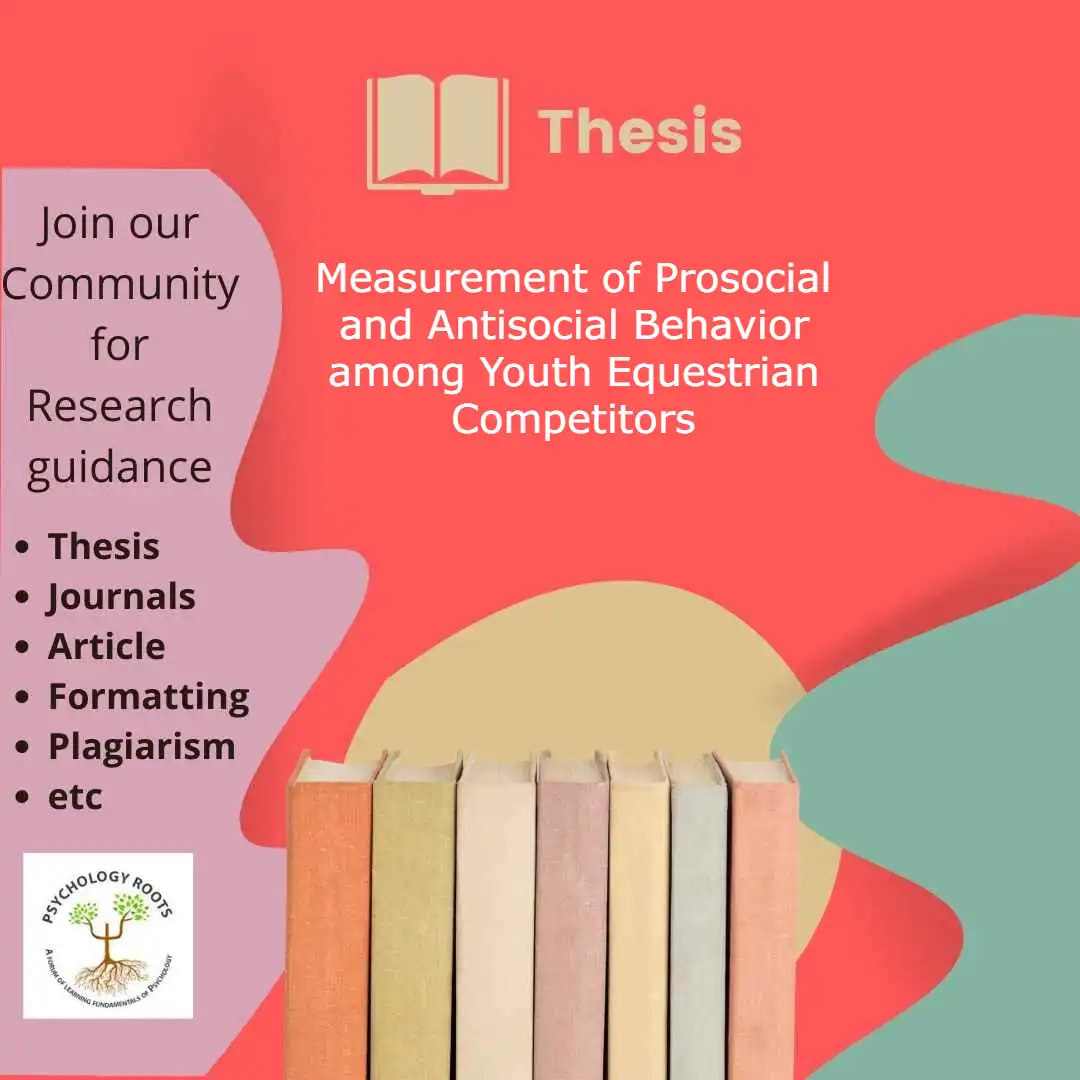Table of Contents
Measurement of Prosocial and Antisocial Behavior among Youth Equestrian Competitors
Here in this post, we are sharing the full Psychology thesis on “Measurement of Prosocial and Antisocial Behavior among Youth Equestrian Competitors“. You can read the abstract of the thesis with a download link. We have thousands of thesis in our collection (See articles). You can demand us any article related to psychology through our community, and we will provide you within a short time. Keep visiting Psychology Roots.
Abstract of the thesis
According to the American Horse Council (2005), there are approximately 9.2 million horses in the United States. Contrary to popular belief, more horses are shown (i.e., compared to one another in various classes of conformation or skill) than raced. While the number and scope of studies of competitive equestrian activity is limited, the general areas of concern in equestrian sport parallel those in more traditional sports. Based on a survey conducted at a Michigan State University Extension workshop on horse show ethics, the top five ethical concerns pertaining to horse shows were matters of sportsmanship, horse welfare issues, violations of rules and regulations, concerns about fair judging, and parenting issues (Skelly, Heleski, Tomlinson, Zanella, & Waite, 2005).

Measurement of Prosocial and Antisocial Behavior among Youth Equestrian Competitors
There is a disconnect, however, between the often held belief that participation in competitive equine activity teaches sportsmanship and the fact that the equine industry is calling for improvements in sportsmanship behavior and animal treatment at horse shows. Therefore, the research objectives of this dissertation were to (a) quantify the incidence of aggressive riding behaviors of youth horse show participants, (b) quantify the conflict, stress, and frustration behaviors of the horses they ride, and (c) determine the relationship between aggressive riding and horse behavior. The objectives of the second study were to (a) develop a preliminary scale for measuring prosocial and antisocial behavior in equestrian sport and (b) to verify the psychometric properties of such a scale.
The first study examined the frequency with which aggressive riding was used in a youth cloverleaf barrel race, and questioned the belief that the use of aggressive riding techniques, considered by some to be poor sportsmanship, would result in a horse running faster, thus improving final run time. These data suggest that across all horse and rider teams studied, there was wide variation in the employment of aggressive riding tactics, but there was no relationship between aggressive riding technique and final run time. There were small but significant relationships between the use of aggressive riding technique and conflict/stress/irritation behaviors displayed by the horse, however. The second study focused on developing a preliminary scale to define and measure sportsmanship in competitive youth equestrian events.
The research protocol in this study used an approach developed by Kavussanu and Boardley (2009), while keeping with the views of Vallerand, Deshaies, Cuerrier, Brière, and Pelletier (1996), who suggested that “athletes should be in a prime position to identify the nature of the sportsmanship concept” (p. 91). The development of the Prosocial and Antisocial Behavior in Equestrian Sport (PABES) scale described in this dissertation went further in that it also included the perspectives of horse judges and show managers, parents of equestrian competitors, and coaches, trainers, and 4-H leaders. This process resulted in a noteworthy start in the development of the scale; however, further work is needed to develop items to appropriately measure the construct of “respect for the horse.”
In addition, any modified scale should be retested with a sample of youth participating at introductory or 4-H levels, which may improve the fit of the model overall. Given the broad scope of age, competitive experience level, and differences in discipline, future tools to measure sportsmanship in equestrian sport may start with a common, respect-based definition, but will need to focus on specific aspects of a specific discipline or audience to develop a valid instrument.
Researcher of the Thesis
- Karen L. Waite
Avail Thesis [sociallocker id=64051]
[/sociallocker]
Need help in Research:
Are you struggling in research? Don’t Worry, We provide you with complete guidance and support free and quickly. Just need to create a query in our community. We also offer paid services such as:
- Thesis writing
- Article writing
- Statistical analysis
- Reference according to APA
- APA Formatting
- Supervisions
- Courses and Training
Contact us for the best quality free and paid services. info@psychologyroots.com or (+92-3336800644)
Information:
The purpose of our website is only to help students to assist them in finding the best suitable instrument for their research, especially in Pakistan where students waste a lot of time in search of the instruments. It is totally free of cost and only for creating awareness and assisting students and researchers for good research. Moreover, it is necessary for you to take the permission of scales from their representative authors before use because copyrights are reserved by the respected authors.
Help Us Improve This Article
Did you find an inaccuracy? We work hard to provide accurate and scientifically reliable information. If you have found an error of any kind, please let us know.
Add comment. we appropriate your effort.
If you have any scale or any material related to psychology kindly share it with us at psychologyroots@gmail.com. We help others on behalf of you.
Follow